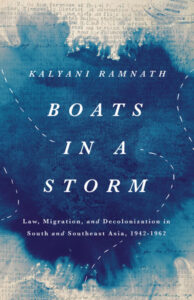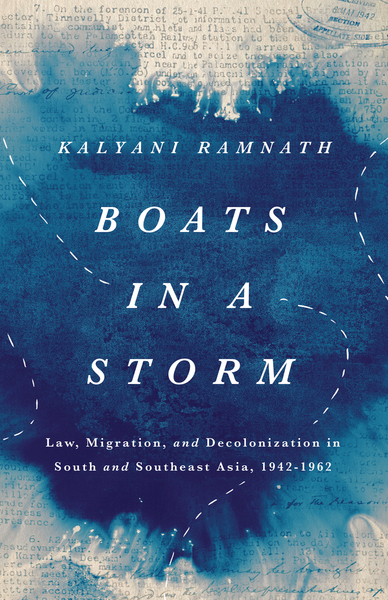 Kalyani Ramnath’s Boats in a Storm contributes to the ever-growing body of literature using legal archives to help reconstruct a supernational history of the Indian Ocean World. And she does so in a refreshing, impressive, and layered way. Continuing in her role as a bottom-up legal historian, Ramnath convincingly sets out on an exploration of what she calls “seemingly mundane”, “unimportant”, and “inconsequential” encounters between migratory people and law in differing national contexts, including Ceylon/Sri Lanka, following the Second World War.
Kalyani Ramnath’s Boats in a Storm contributes to the ever-growing body of literature using legal archives to help reconstruct a supernational history of the Indian Ocean World. And she does so in a refreshing, impressive, and layered way. Continuing in her role as a bottom-up legal historian, Ramnath convincingly sets out on an exploration of what she calls “seemingly mundane”, “unimportant”, and “inconsequential” encounters between migratory people and law in differing national contexts, including Ceylon/Sri Lanka, following the Second World War.
The encounters she unearths mostly relate to everyday dealings like income tax, debts, loans, or transmitting (or inheriting) money to (or from) family abroad. However, when connecting them, Ramnath reveals all sorts of political, social, and cultural implications when it comes to matters like citizenship, business, migration, family life, and community-formation in a changing, post-colonial South and Southeast Asia.
To give an example, she shows that decolonisation was in no way just a political, economic, or diplomatic affair – even though the literature on the region has mostly focused on such top-down aspects – but also a legal phenomenon that primarily affected the lives of common people, like contract labourers, artisans, and dockworkers.
Similarly, she highlights how the post-war national frameworks started to make life difficult for families that had historically been spread out across the Indian Ocean – while at the same time showing that these actors became increasingly capable in navigating such nation-state bound legal and administrative structures.
She starts this history in 1942, with a vivid description of a world in ashes. The disintegration of the British, French, and Dutch overseas empires – largely built through Asian capital and labour as Ramnath notes – by the Japanese forces, marked the beginning of a much deeper change.
The first chapter, however, does not initially discuss structural changes that came with the ousting of European (legal) powers, but instead focusses on the migrants – the people who had to flee the bombed cities and the burning paddy fields. This sudden peak in mobility fuelled the already existing anti-migration discourses amongst both local societies and colonial governments alike, particularly surrounding migration from India. As such, many refugees attempted to return to the places they left behind after the war, but when they did, they encountered a wildly different world than the one they had left behind.
Particularly those who worked or did business in more than one of the newly forming nation-states – like the Chettiars described in the second and third chapters. The Chettiars faced increasingly restrictive and nation-state oriented legal, monetary, and administrative structures that often did not recognise or cooperate with those of the other countries involved (or those imposed by the Japanese during the war). People who had made their business in super-regional moneylending and had relied on existing unified notarial, financial, and legal frameworks to uphold such constructions, suddenly found themselves unable to do business as they had. Subsequent legal conflicts show the uncertainty faced by these entrepreneurs and their families (like Seethalakshmi Achi, the widow of a Chettiar moneylender) as they attempted to regain some of their economic prowess from before the war.
On the other end of the economic spectrum, “ordinary migrants and labourers” as described in chapters four and five did not face the plurality of laws and courts as did the Chettiars, but they had to deal with changing bureaucracies that viewed them as displaced, and potentially dangerous strangers. The key word in this lived experience was “paperwork”, as “decolonizing” governments tried to find their footing in a world of passports, visas, and permits. One wonders though whether the post-colonial governments actually decolonised, something Ramnath only reflects haphazardly on (see for example p.15–17), though she never questions the usage itself.
It was people like Mohammed Ibrahim Saibo that were the worst off. Sending money he made from his work in Ceylon to his family in India, landed him in a bureaucratic nightmare of Kafkaesque proportions when he signed as a “temporary resident” while trying to apply for “permanent settlement”. Like him, many others struggled with an increasing number of exclusionary mechanisms, while both the economy and perceptions of the labour they provided inherited from colonial discourses still demanded their presence abroad.
These migrants were not mere victims of attempts by post-war governments to slow the movement of people down (or to stop it completely). Those who became skilled at navigating these hurdles could find themselves gaining citizenship, rights, and even belonging. For most, however, being branded “illegal” and subsequently being “repatriated” to the region the government thought you were from, was very much a reality. As Ramnath highlights, these insecurities that affected the lives of people like Saibo, were the result of larger forces at play. As states like India and Ceylon were reinventing themselves (who belongs?), their economies (how to generate wealth?), and their sovereignty (what is the extent of our territory and power?) – they were also debating who was to profit from the movement of people and money. Branding entire families as collectively alien, and disallowing dual citizenship were active strategies to prevent money from flooding out, and people from flocking in.
In the last two chapters (six and seven), Ramnath shows how the post-war legal and bureaucratic institutions she described in the previous chapters became increasingly and aggressively exclusionary, as global currents like the Cold War became a reality in South and Southeast Asia. Rising tensions regarding the upsurge of Communism in the region began to have a detrimental effect on those who attempted to cross borders (or the sea) in the 1950s and 1960s. Under the guise of protecting public order, such attempts could lead to detention without trial, and as post-war nation-states were still determining where their respective public borders began and ended, migrants were caught in the crossfire – much as we saw regarding changing bureaucracies and categories of citizenship in the earlier chapters.
Additionally, as more and more countries were dealing with (failed) coups and political instability in the 1960s, fear of outsiders, foreign ideologies, and migration led to a further rigidification of borders, laws, and paperwork. If you were not a citizen of the nation-state you wanted to live in by then, it became increasingly difficult to become one. As a result, groups of people who had enjoyed a high level of mobility in the Indian Ocean region for generations were basically left with a choice: continue in their attempts to reconstruct their way of life as it was before the war and face backlash for it, or settle for citizenship (and with it, rigidity) the first chance they got.
With that observation, Ramnath comes to what is arguably her most fascinating conclusion, namely that post-independence Asia, once it ridded itself from European imperialism, in many ways became more disconnected than before. She shows that while national leaders and diplomats met at high-profile conferences and signed boldly stated pacts and agreements on regional solidarity and cooperation, the mobile, ocean-oriented communities found themselves between a “partitioning” rock and a “nationalizing” hard place.
Increasingly framed as “migrants” endangering the public good, these families became a conscious target of legal and administrative efforts by postcolonial governments to rid the nation of such itinerant groups of people. This paired with the growing bureaucratic webs spun by said governments, made it more and more difficult for people to cross borders, practice their super-regional businesses, and engage with international and local law. Moreover, she demonstrates that the actors she studied were well aware of these processes, and made their reservations known to the administrators, lawyers, and jurors they engaged with. However, in reconstructing their family histories, it seems only some remained as mobile as they were before the war, while most others found themselves forced to fit into a new nation-state-oriented world.
In bringing these histories to the forefront, Ramnath does not only offer an interesting new perspective on law and legality in South and South East Asia, but also opens discussions about international relations, communal belonging, and citizenship, in a post-imperial Indian Ocean world. What is specifically impressive is the level of detail, yet accessibility, with which she describes these families, their histories, and their interactions with the plurality of legal and administrative frameworks they encountered. Learning about them, rather than the political idealists and diplomats often placed in the forefront of discussions surrounding the political decolonisation of Asia, is refreshing.
At the same time, it does lead one to wonder, where do these families exactly fit in the larger story? Could they only adapt to the changes noted by Ramnath, or did they also play a role in shaping them? As Ramnath herself notes, in many ways the efforts of “migrants” to recreate their mobile lives from before the war, created the atmosphere in which many of the larger geopolitical developments Ramnath engages with (such as the Asian diaspora, citizenship rights, decolonisation, the making of nation states, etc.) took place. The exact agency migrants had in the processes that they were embroiled in, however, remains somewhat vague. In other words, where their influence exactly began and ended is not completely resolved.
Related to that, the reader is left wondering whether the experiences (and agency) of socioeconomically powerful entities like the Chettiar business families described in the first chapters, is comparable to those of the migratory labourers described in the latter ones. For example, Ramnath shows that Chettiar business families were petitioning against the partitioning of India, and thus showing their awareness of using legal frameworks to actively try and change policy. In contrast, one could wonder if common people like Saibo had the social capital to even try and improve the system to their own benefit. In the end, when in a storm, it matters a lot in which boat one finds oneself. A difference Ramnath does not really address.
That said, Ramnath’s book is a commendable effort to connect both a diverse range of historiographies – not only between different national contexts, but also between legal, social, political, and cultural histories – and “worlds”. Worlds once connected, but decreasingly so post-war as Ramnath observes. This counter-intuitive but apt conclusion alone makes this book a must-read for any scholar interested in global histories of law, citizenship, and belonging. Vice versa, for a Lankan audience this book shows how dynamic and connected life in the Indian Ocean world was pre-independence, and critically unearths the efforts of national governments like the one in Ceylon/Sri Lanka to bring an “uneasy calm” to the stormy seas of migrant life.
Luc Bulten is a lecturer and postdoctoral researcher with a special interest in the social and economic history of Early Modern South and Southeast Asia. In his current project at Leiden University, he studies the economic activities (specifically surrounding money lending) of Asian merchants in Dutch and British Melaka (1750-1850).
Image Source: https://bit.ly/4bIQgDu

